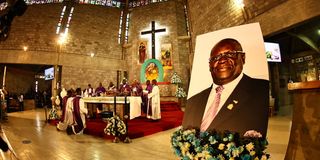Why Luo elders banned cattle ritual at Magoha funeral

Former Education CS Prof George Magoha Requiem mass going on at Consalata church, Nairobi on February 9. Gem elders have said Tero Buru ritual will not be conducted during his funeral.
In Luo culture, a funeral is not complete without rituals to celebrate the departed and drive away the spirits of the dead. Tero Buru is one such ritual.
It is one of the Luo traditions performed at the funeral of an elderly person or prominent figure in the community, before the body of the deceased is taken to the grave for burial.
During the ceremony, elders and selected youths take a herd of cattle to the home of the deceased where the animals are then driven crazily around the home.
Those involved in the ritual usually wear traditional war regalia, which includes hides and sisal hats.
They also carry twigs while wearing the famous akala (tyre) sandals.
The mourners run around the homestead of the deceased, some holding the horns of the already charged animals and run with them while singing dirges and chanting war songs.
All the while, the homestead is full of dust which is referred to as ‘buru’ in Dholuo.
In cases where the body has been placed in the house of the deceased, one or two bulls are shoved inside the house to drive away spirits.
After all this, the herd of cattle is driven towards the nearest water body -- mostly rivers or lakes -- where the evil spirits are believed to be destined for.
After the dust settles, the villagers return to the homestead and drink traditional brewed alcohol while singing and dancing around the casket.
While the former Education Cabinet Secretary George Magoha fits the stature of an elderly and prominent Luo leader who has died, the Gem Luo Council of Elders has ruled out this common ritual at his funeral.
Christian values
Bishop Martin Arara, the coordinator of the Gem Council of Elders maintained that the family has chosen to hold a Christian send-off for their relative.
“This is a Christian family and since such traditional rituals are usually fronted by the family, they have not done so, therefore we will not be carrying out Tero Buru,” said Bishop Arara.
He also added that the wife being a foreigner, they will keep off Luo traditions that may make her and some mourners uncomfortable.
He also added that some of the traditions are slowly becoming outdated and people are no longer keen on performing them during funerals.
The Luo elder said that is why nowadays wife inheritance is also discouraged in the Luo community.
Bishop Arara, however, said they will allow one ritual known as Sigweya in some sub-tribes and Gweyo in others.
It refers to chanting done by individuals who also invoke the name of the deceased recalling the fond memories they have of the departed.
“We will allow Sigweya for those who want to do it. This is what Raila Odinga usually does in the funerals of prominent Luo persons while carrying a fly whisk and later chants 'Jowi, jowi, jowi',” said Bishop Arara.
The Luo council of elders has been invited to the funeral on Saturday and the members are required to be seated by 7am.
Prof Magoha's body is set to arrive at the Yala Township Primary School at 1pm on February 10.
Thereafter, there will be a procession to St Mary's High School, Yala, led by the Starehe Boys Centre Band.
At 2pm, the body will be taken to Prof Magoha’s home in Umiru village, where there will be a requiem mass and tributes.
The body will lie in his home overnight ahead of the burial.
On Saturday morning, a procession will be held by academicians from the late Prof Magoha’s home to Maseno University's Odera Akang’o Campus in Yala where the funeral service will be held, and later, family members led by the clergy will accompany the body for the final burial rites at his home.
However, some cultural practices were maintained since the grave of the former Education CS has been dug behind his home according to the Luo culture.
Many rituals that were previously conducted at Luo burials are rarely practised these days. For instance, shaving of the head after the burial. This was done in front of family elders. Hair is considered to contribute a lot to beauty and its removal is a sign of mourning. This act also helped to identify the family of the deceased.





